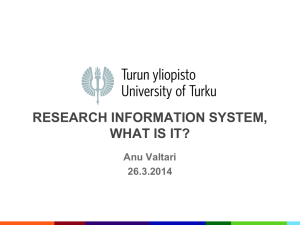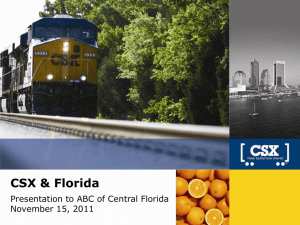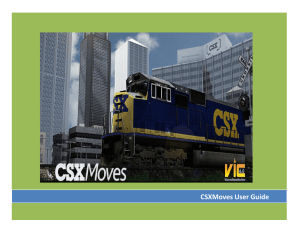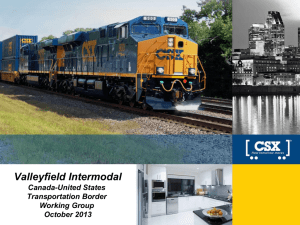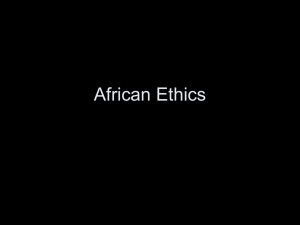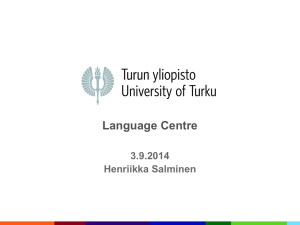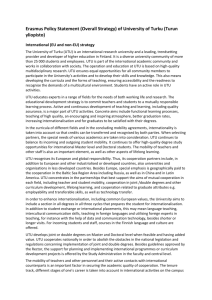UTU-CSX Safety Model 2013
advertisement
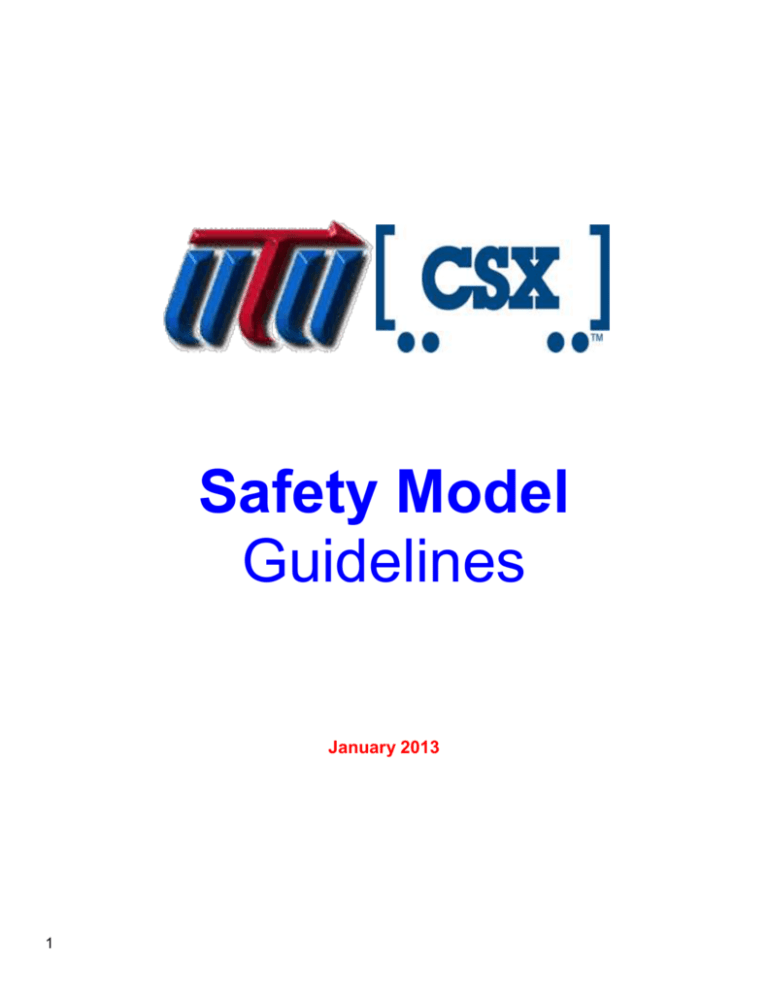
Safety Model Guidelines January 2013 1 Open Letter – United Transportation Union Membership – CSX Employees In 2000, United Transportation Union and CSX Transportation recognized the value of working together while providing a safe work place for everyone at CSX. Our efforts are based on a common theme that each employee can return home in the same condition as when they reported for duty. To that end, CSXT and UTU began using full time Safety Coordinators, who maintain continuous oversight. Under the Model, the UTU and CSX have continued to provide Coordinators additional training. The Labor/Management curriculum is focused on people skills through positive communications. Each Coordinator is expected to demonstrate a solid example of fraternalism while increasing safety awareness to each CSX employee and UTU Local having jurisdiction on CSX. The Model continues to be updated for the simple purpose of providing opportunities to enhance safety. The latest change includes the insertion of peer intervention, which has proven to be the most successful method of changing unsafe habits and increasing a positive attitude in the work place. The positive interaction between co-workers will not be used in any form of discipline and will not be a matter of record. We are confident that the improved UTU/CSX Safety Model will continue to provide the necessary tools for success in Safety for both UTU and CSX. We urge you as members and employees to continue the movement to a safer work place and urge you to utilize this and any other tools available to facilitate that process. _______________________ M.B. Futhey, Jr. International President United Transportation Union 2 _____________________________ David Brown Executive Vice President & Chief Operating Officer CSX Transportation, Inc. Mission Statement The following guidelines represent a collaborative effort to improve the system wide structure of the current UTU/CSX Safety Model. Most importantly, this effort enjoys the support of the top officers of both Organizations. The following team structure was formulated by incorporating the successful attributes of various safety teams throughout the system. A successful Safety Team is one that benefits Labor as well as Carrier. They must work hand in hand. When either the carrier or labor becomes too overbearing and/or uncooperative, the final result is an unsuccessful Safety Model that benefits no one. This has been proven in many instances throughout the system and within the industry. In the true spirit of safety we present the following guidelines that can and will produce the safe and injury free work environment that we are all striving for. The UTU/CSX Safety Team is committed to serving the needs of all rail workers across the CSX system. Our focus is on providing a safe work environment for our members in the industry as well as behavior issues and concerns. We also recognize that things outside the immediate work environment have a real impact on returning workers home to their families after every tour of duty. Our promise to every worker on the CSX system is that we will work tirelessly and proactively to meet your needs in providing both the necessary training (with the use of the latest technology and information) and a safe work place to ensure a long and satisfying career. We will act responsibly, exercising the highest moral and ethical conduct in our interaction with co-workers and employer. We will promote the inclusion of all of our peers in that effort by promoting personal ownership of the program. Our most important mission will always be a safe and injury free work environment. To insure diplomacy and prevent conflict of interests pertaining to previous contractual issues, investigations and pre-conceived prejudice with local management the UTU Local Chairpersons should be involved in all aspects, attend local safety meetings and be in complete support of the program, but should not hold a position on the local safety team. Local Legislative Representatives, providing they are not also Local Chairpersons, are encouraged to run for an elected local safety team position. 3 A successful Safety Model is one that is labor driven and supported by all levels of management. Without the support and participation of all, it becomes a directive, not a program, promoting resentment toward the carrier. A member must feel ownership of his/her program and believe their input and participation is valued. The structure of the local safety team must be uniform throughout the system. Chicago must be the same as Waycross, etc., using the same guidelines for team structure, meetings, and forms and reporting procedures. UTU/CSX Safety Coordinators will ensure this. Instead of fragmented procedures and viewpoints, we will ultimately have one large team, with a unified voice, working towards a common goal, a Safe/Injury Free Work Environment. A UTU Executive Safety Board will consist of the following members to provide oversight of the Safety Model: UTU Vice President(s) UTU/CSX State Legislative Director’s Representative UTU/CSX General Chairperson’s Representative UTU/CSX Yardmaster’s Representative UTU Local Safety Team Structure The UTU Local Safety Team should consist of a minimum of two positions, which would include a Safety Team Chairperson and Safety Team Secretary that will have jurisdiction defined by the territory of the respective Local Chairpersons. Where a Local Chairperson’s committee is less than twenty (25) members, the committees may be combined with that of another Local Chairperson. A Safety team Vice Chairperson may be established where the need is evident. UTU Local Safety Team positions and vacancies will be elected by secret ballot as outlined below. Each position on the Safety Team will be for a term of two (2) years. Candidates should be UTU members of good standing and moral character actively working in their craft. If there is a nominee in question, their appointment will be reviewed initially by the Local CSX manger and UTU Safety Coordinator. If a consensus cannot be made then the issue will be presented to the respective General Chairperson(s) and CSX Division Manager for handling prior to the election. 4 Elections Nominations must be filed with the secretary of the Local not later than the last regular meeting in October in the year of the election. The number of safety team positions, as dictated by the provisions above, will be filled by a UTU membership vote for those nominated during the November meeting. Those elected will assume the positions effective January 1 of the following year. Safety Representative elections will be conducted as provided within Article 57 of the UTU Constitution by either a: secret ballot election from those members in attendance at the November meeting or referendum vote with any and all applicable cost bore from the Local. Alternative election methods may be used if properly posted and correspond with Local by-laws. Election results shall be forwarded to the corresponding Safety Coordinator. When a Safety team vacancy is created by resignation, member not in active service or in extended training, the position will be filled temporarily by the candidate with the 2 nd highest vote total. If an alternate is not available, a vote of new nominees for the temporary position shall be held using the aforementioned voting procedures at the next Local meeting. Yardmasters will have a safety representative in terminals where UTU safety teams are established. Yardmaster safety team members will be elected by the Yardmasters at that terminal, using the same voting methods as described previously. The appropriate UTU/CSX Safety Coordinator must be notified. Removal of Safety Team Members If a Local member(s) believes it necessary to remove a safety team participant, a written complaint will be forwarded to the local. The Local will consider the charges at this meeting providing a proper quorum is present. If a motion was passed for removal, the Local Secretary must post a notice for a vote to take place at the following month’s regular scheduled meeting. A Secret Ballot vote will take place with a simple majority of votes cast determining the outcome. The disposed safety team member may, within 15 days of removal, forward a written appeal to the respective General Chairperson. A final decision on removal will be made by a majority vote of the affected State Director, General Chairperson, and UTU Vice President(s). NOTE: Said member will be relieved from their Team responsibilities until final ruling is received and may not perform any compensated safety duties in the interim. 5 If issues arise on the participation of a safety team member from CSX management, the following procedures will be used when complaints are received; The CSX officer shall contact the corresponding UTU Safety Coordinator, providing details of the complaint The UTU Safety Coordinator will meet with the Safety Representative and CSX officer in efforts to resolve the alleged issue. If a resolution cannot be accomplished at a local level the issue will be forwarded by the UTU Coordinator to the CSX Division MSOP for further review. The coordinator will also notify the corresponding General Chairmen. If consensus is still not found then the issue will be presented to the affected General Chairman, UTU Vice President(s), State Legislative Director and applicable CSXT General Manager for a final verdict. UTU Safety Team Meeting Format A UTU safety team meeting, including the UTU Legislative Representative and/or Local Chairperson, (no alternates), will be held each month. This day should be the same every month i.e. 2nd Tuesday of each month, and un-compromised unless under emergency situations, or agreed to by all parties involved. While attending this meeting, team members, including the UTU Legislative Representative and/or UTU Local Chairperson will: Establish goals Initiate, develop and review on property crew contacts Initiate and provide peer intervention to enhance rules compliance Review action items corrected and develop a progressive plan to correct all remaining issues Formulate a report that will be presented at the local union meeting covering all current activities of the safety teams Develop of an **itinerary for next month’s activities. Both the month ending report and itinerary should be posted on the UTU Safety bulletin board for the benefit of all members as well as copies forwarded as listed below. 6 A daily agenda sheet will be forwarded to the responsible CSX Manager with the report which includes the number of contacts made and the material/subjects discussed. While attending the local union meeting, the safety team’s report of previous month’s activities as well as their itinerary will be read to all present. In addition to this, the meeting should be opened to concerns, questions and ideas from the membership. Keeping our membership informed and involved is an integral part of this program as they are the biggest contributors and disseminators of information. * As noted, we do not advocate the marking off for safety related duties on Friday, Saturday or Sunday. Also, under most circumstances do not recommend Monday meeting dates as committee members will have to mark off on the weekend to attend. ** Itineraries must include the following: Names and ID numbers of those participating. The activities planned and the date and location that will be involved. Itineraries must be completed prior to the next month’s activities. This will be completed and sent along with the past month’s report to the CSX Division Manager, Division MSOP, responsible CSX Manager and UTU State Legislative Director, General Chairperson and UTU/CSX Safety Coordinator by either the Safety Chairmen or Secretary via fax or e-mail. CSX Safety Committee Meetings A local CSX Safety Committee Meeting will be held monthly with CSX management and all other crafts in attendance. To better utilize allotted safety days, this meeting should be scheduled, if possible, to coincide with the UTU Safety meeting day. The UTU Safety Team Chairperson will be the designated representative at the CSX Safety Committee Meeting. The UTU Safety Team Vice Chairperson (where applicable) and Secretary may also be in attendance if authorized by Local CSX Management. The CSX Safety Committee Meeting should be co-managed, in a team-oriented format, with shared responsibilities by all union representatives and CSX Managers, as defined by the CSX Safety Committee Resource Guide. 7 Safety Agenda Meetings are only a small portion of our safety agenda, activities have been and will continue to be developed and implemented to promote positive reinforcement of 100% rules compliance and safety awareness on a consistent basis with our members and by their peers. This has to be done down on the ballast line thru crew contacts. All Safety Team members, including Local Chairpersons and Legislative Representatives if present, will participate. Through education and communication we will make an impact. The dissemination of accurate information to our members and fellow employees, whose lives depend on it every day, is vital. This is the responsibility of each and every member of the safety team structure. A concerted effort must be made prior to or following each safety meeting to conduct crew contacts to spread the information accumulated at said meetings and additional “safety blitz” days should be organized with your local CSX officers. *Safety contacts and the information shared while doing so, must not be limited to just safety days. As safety leaders we must continue to be a source of accurate and timely information. Defined Roles and Responsibilities of Team Members, including Local Chairpersons and Legislative Representatives Participating Team Members’ duties will include: Promote rules compliance Promote positive reinforcement and peer intervention Prepare, distribute and follow detailed monthly agendas Participate in CSX Local Safety Committee activities, i.e. Cookouts, Safety Blitz, Health/Wellness Screenings, CPR/First Aid Training, etc Communicate directly with ballast line employees. Solicit their viewpoint of safety and address their safety concerns. Safety Team members should have open lines of communication with local CSX Management. 8 Yard facility and industry inspections Participate in the local Safe Returns efforts. Daily Rate of Pay & Days Allotted UTU Safety Team persons involved in safety activities or meetings throughout the system will be the current agreed to rate per day without overtime. The code established will be “SF” and will be utilized only for UTU safety team persons. Note: Yardmasters pay code will remain SMP. A minimum of an 8-hour day is required for all Team Members while performing defined safety activities. Marking off on Friday, Saturday or Sunday is not recommended unless approved by local management or special event and should not be done on a consistent basis. This will ensure that the credibility of the program and its participants will stay intact. Failure by Team Members to perform the required duties listed above may result in forfeiture of Safety compensation. The minimum days allotted each Team, consists of the following: Local Chairperson and Legislative Representatives 1 day a month to perform defined safety activities, reporting their safety activities to the responsible CSX Manager. All other elected Safety Team members, 2 days each. Employees that are required to lose compensation for two (2) days of work to perform safety activities will be compensated for both days at the appropriate safety rate, but the employee must perform safety activities on both days. The responsible CSX Managers may allocate additional days for various safety activities. These days can consist of safety blitzes, Safety skills seminars and ad hoc committees etc. The Safety Chairman will assist Management with selecting and scheduling Team Members to work the various activities. 9 Mark Off Procedures Safety Team members, Yardmasters, Local Chairpersons and Legislative Representatives, will be permitted to mark off to perform safety related duties Monday, Tuesday, Wednesday and Thursday without restriction. (Team Members marking off for safety activities must mark of utilizing Safety and/or Company Business, not Union business. Marking off Union business will result in non-payment for that Safety activity.) Mark off on Friday, Saturday or Sunday, will be permitted only with the authorization of CSX management or under the guidelines as described under the UTU Safety Coordinators duties in this Model. An initial, one (1) time, list will be forwarded as to who is on the UTU Safety Teams to the local CSX Manager, with changes updated as they occur. The meeting dates being set as well as the forwarded itineraries will coincide with the mark offs. In some incidents, a safety team member may have to mark off in advance to ensure they are available to attend a function. It is also noted that under only emergency situations should a safety event be postponed and this should be agreed to by all related parties including the UTU Safety Coordinator and local CSX Manager. UTU/CSX Unsafe Condition Form This form will be two-sided with the front allowing for accurate descriptions of unsafe conditions or acts and the backside for Team Member use. Its principal attribute is the ability of the Safety Team Members to consistently and easily track individual reports and the progression that each has made and the person reporting the unsafe condition/act the option of how they would like to see it corrected. Once again this promotes ownership of our UTU/CSX Safety Model. More importantly, this will allow for documentation to be provided to the party that is responsible to correct the unsafe condition/acts, thus holding them responsible for promises made. A follow-up call should be made to the person who filled out the report originally and ask if the correction was satisfactory as well to the person responsible in correcting it. The follow-up procedure is important to promote continued participation. 10 A Safety team member that has been placed in charge of an unsafe condition report must do so in an expeditious way. You do not have to wait until a meeting is to take place to pass it along to the corrective party. Below, please find the proper unsafe condition reporting procedure: PI-82/Unsafe condition report is received and copied to a designated local CSX officer, Safety Chairperson and responsible party for correction. (UTU Safety Chairperson will always maintain copies of all unsafe condition reports to allow follow-up.) A 10-day response by Local Management/Corrective party, detailing a plan for correction forwarded to the Safety Chairperson. Conditions reported beyond the resources of local CSX management will immediately be passed up to the Division level. 30-day completions date from date of report. If not completed, pass up to UTU Legislative Representative, CSX Division Officer and UTU Safety Coordinator. If, after all aforementioned procedures have been followed and no activity has taken place or it is deemed as needing expeditious handling, the UTU Safety Coordinator may request assistance from the assigned UTU Vice Presidents and affected General Chairmen. 24 Hour Hot Line A 24-hour safety hot line should be established and provided on a Terminal and/or Divisional level by CSX, as well as an answering and fax machine made available for each Team. The Hotline number will be posted at each terminal and listed in a divisional bulletin. This gives an alternative means of reporting unsafe conditions/acts if anonymity is desired or forms are unavailable. A committee member must check this daily to ensure that reports are handled in a timely manner. 11 Peer Intervention Process Mission Statement The Peer intervention process is a Union initiated – management supported program that uses peer intervention to address unsafe acts through peer intervention. Peer intervention has proven to be the most effective method to change unsafe behaviors by encouraging rules compliance. We cannot continue to ignore the impact of unsafe behavior in our work environment. As a responsible Union member and professional employee, each of us is obligated to intervene and address an unsafe act when it becomes apparent. Principles Principles of this concept include attempting to resolve conflicts at the lowest level of involvement wherever possible. The following principles are paramount to a successful intervention: Confidentiality Trust Non-judgmental Intervention Mutual Respect Continuing Support Intervention Process UTU Safety Coordinator will be responsible for the administering and the oversight of the process and is available to provide assistance in the intervention process. Peer Intervention Stages Peer to Peer - (Employee accepts responsibility for telling co-worker about unsafe behavior.) Local Chairperson, Local Safety Team Chairperson to Peer - (Alternative to first step.) At no time are any of the involved parties permitted to disclose details of any intervention to management because it violates rules of confidentiality. Other than the number of interventions held, no other records will be kept of this process. The process is totally independent of the company discipline policy. 12 UTU/CSX Safety Coordinator’s Duties To assure the success and uniformity of this program, the position of UTU/CSX Safety Coordinator is imperative. In the event of conflict, he may act as a mediator, but in most cases will act as an observer, educator and motivator. The natural reaction of a Safety Coordinator would be to correct problems, instead their role will be to guide and teach members how to properly communicate and report unsafe conditions/acts while enhancing positive behavior and 100% compliance within the work place. Their duties will include: Maintaining a uniform and stable safety program. Promote rules compliance Promote positive reinforcement and peer intervention Facilitate changes in procedures Assist in the development of training programs/action plans for the future. Empowered to resolve safety committee, mark off issues with crew management when a local CSX officer isn’t available. Attend Local and Division Safety meetings Assist Local Safety Committees with various Safety activities, i.e. Cookouts, Safety Blitz, Health/Wellness Screenings, CPR/First Aid Training, etc Communicate directly with ballast line employees. Solicit their viewpoint of safety and address their safety concerns. Safety Coordinators should also have open lines of communication with CSX system, regional, divisional and terminal management. To insure uniformity on a system-wide level, Safety Coordinators will participate in monthly conference calls to share ideas, goals, concerns, and successes. 13 UTU SAFETY COORDINATOR – CONTACT INFORMATION: Huntington Division Kris Jones csx_trains@msn.com kris_jones@csx.com Cell: 606-233-2962 Office: 606-439-7206 Fax: Huntington Division David Stayton smoknhd@aol.com David_Stayton@csx.com Cell: 540-958-2753 Fax: Chicago Division Jerry Gibson JL-Gibson@comcast.net Jerry_Gibson@csx.com Cell: 616-308-6381 (Does not use nor respond) Baltimore Division Edward R. Melodini emelodini@comcast.net edward_melodini@csx.com 412-302-0079 Fax: 412-835-5151 Florence Division Darren Ferrell dferrell88@aol.com Darren_Ferrell@csx.com Cell: 843-696-5687 Fax: 843-875-1934 Fax: 904-306-5063 Nashville Division Brian Hall BCHall97@yahoo.com Brian_C_Hall@csx.com Louisville Division Terry Tyrrell terrymt@bellsouth.net Great Lakes Division Kyle Brooking kdb21@sbcglobal.net Atlanta Division Dewayne Gray dewaynerail@yahoo.com Jacksonville Division Mark Patrick mm6569@msn.com Albany Division Mike Fink mdfink@nycap.rr.com mike_fink@csx.com Cell: 518-469-4182 Office: 518-767-6126 Fax: 518-377-0362 fax is also home telephone # Yardmaster Rep. Doyle Turner Doyle_Turner@msn.ocm Doyle_Turner@csx.com VP International David Wier vpwier@msn.com VP International John England jengland@smart-union.org 14 Cell: 618-384-6294 Terence_Tyrell@csx.com Cell: 502-930-6351 Kyle_Brooking@csx.com Cell: 317-417-9888 clyde_d_gray@csx.com Cell: 803-507-5304 mark_r_patrick@csx.com Cell: 727-692-6941 Cell: 606-922-2531 Cell: 216-712-1945 Cell: 626-422-1674

